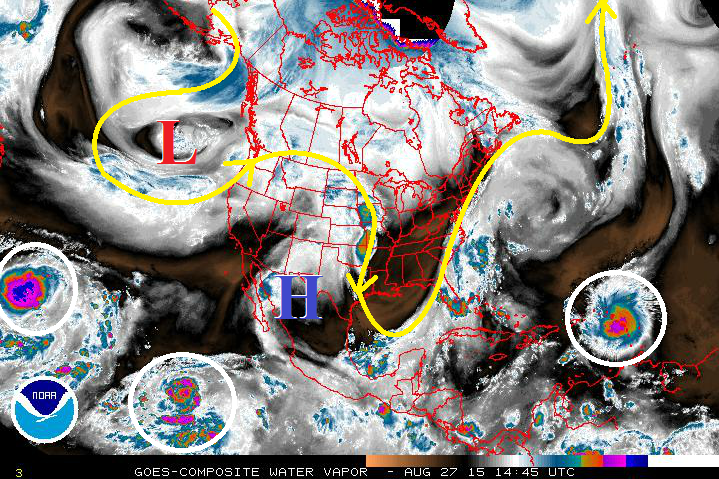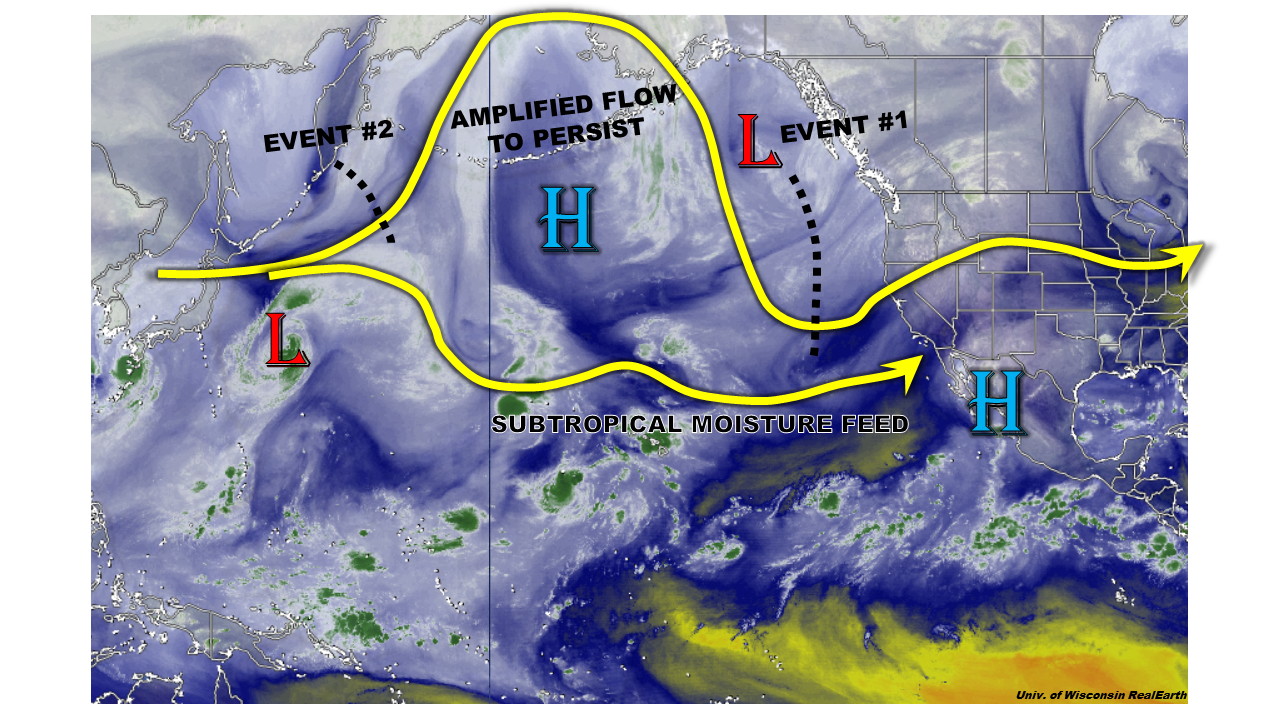Issue Date: 8/27/2015
Issue Time: 12:35 PM
There are 5 main features to pick out of the water vapor image below: Tropical Storm Erika in the Atlantic, Tropical Storm Jimena (right) and Hurricane Ignacio (left) in the Pacific, high pressure ridge over the central/western US, and the low pressure trough off the west coast of the US and Canada. Tropical Storm Erika does not mean much to our forecast, but it will be interesting to watch over the coming days with regards to its track, intensity, and longevity. Jimena and Ignacio will continue to move westward further into the Pacific, and are also without impact to Colorado.
The high pressure ridge and low pressure trough, and how they interact with each other, will be the main story of this FTO period. As hard as the low pressure trough tries, the high pressure ridge is not ready to give up ground. As those two systems duke it out, monsoonal moisture will come and go, along with associated disturbances. The low pressure trough will also eject a few shortwave troughs through the forecast period, but the best broad-scale support for thunderstorms will likely be too far north to really mean a prolonged/elevated flood threat for Colorado. In the event discussions below, I have highlighted 3 “event” periods, none of which provide an apparent flood threat. In a weather regime such as this, the daily Flood Threat Bulletin’s will be crucial because the amount of moisture/instability/support will fluctuate daily. Stay tuned.
Event #1: Saturday (08-29-2015) through Tuesday (09-01-2015)
No Apparent Flood Threat from mostly “Garden-variety” Thunderstorms
Weak south/southwesterly flow aloft will return as the ridge axis gets pushed east of Colorado by the upper-level trough. This will bring some moisture back into Colorado, providing an uptick in precipitation over and adjacent to the mountains. Low-level moisture east of the mountains will be a bit on the low side, so most storms will be garden variety with brief light-to-moderate rainfall. Over the mountains, moisture will be better overall, so locally heavy rainfall will be possible. At this time, precipitation totals from the 4-day event are not that spectacular, with most areas receiving a half-inch or less. No flood threat designation is warranted at this time.
Event #2: Thursday (09-03-2015) through Sunday(09-06-2015)
No Apparent Flood Threat with a Near-Repeat of Event #1
Nearly a repeat of Event #1, the upper-level trough off the west coast forces the ridge axis back to the east, bringing south/southwesterly flow aloft back to Colorado. This will bring an increase in moisture, once again, though how deep the moisture will be is to be determined. The upper-level trough will eject another shortwave during the second half of the period, but the best support for thunderstorms will remain north and east of Colorado. With the amount of moisture present still coming into focus, no flood threat designation is warranted at this time. The precipitation map below is what current observations/analysis suggest, and is subject to revision for the next FTO. Stay tuned.
Event #3: Tuesday (09-08-2015) and Wednesday (09-09-2015)
No Apparent Flood Threat as This Event is Still Coming into Focus
After a short-lull, Event #3 will be a quick-hitter. The upper-level trough that was anchored along the West Coast looks like it will finally get its way, pushing to the east in a fairly quick fashion. Following this event, it appears things may be quiet through the following weekend. Details will come into focus over the coming days, so check back in the next edition of the FTO on Monday.







